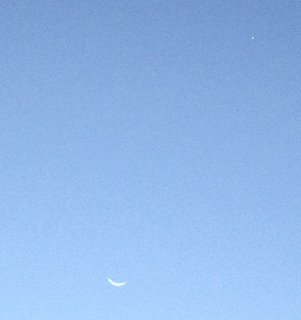Saturday, November 05, 2005
Daytime Venus
 See that dot just up at the top righthand side. That's Venus, the unusual thing is that image was taken in daytime. Now, I have to tell you that this image is photoshopped to the max, that I have maximized every attribute to make Venus and the Moon stand out as more than vague "might bes" on the computer screen. But while imaging these things was a right royal pain, they were as obvious as canine genitalia to the unaided eye.
See that dot just up at the top righthand side. That's Venus, the unusual thing is that image was taken in daytime. Now, I have to tell you that this image is photoshopped to the max, that I have maximized every attribute to make Venus and the Moon stand out as more than vague "might bes" on the computer screen. But while imaging these things was a right royal pain, they were as obvious as canine genitalia to the unaided eye.Venus is currently bright enough to see with the naked eye. But locating a not too bright dot in a field of bright blue can be difficult. If you have a guide, like the Moon, it can be a lot easier. At 6:30 pm ACST, the Sun was roughly 15 degrees from the local horizon. I used the house roof to obscure the Sun (always be very careful to avoid staring at the Sun to prevent damage to your eyes). Looked up about 40 degrees to find the Moon, which was a fairly obvious crescent, then 6 degrees above that (and slightly to the side) was a very obvious Venus.
You have a chance to find Venus easily in daylight tomorrow. Venus will be 5 degrees below the Moon. So an hour or so before the Sun sets, find a nice spot where the Sun itself is blocked from View, but there is a good clear northwest sky. Look up to about 3/4 of the way to the Zenith (70 degress or about 12 handspans) in a northwesterly direction and the crescent Moon should be obvious. Look below the Moon by about 4 finger widths (roughly 5 degrees) and Venus should be an obvious bright dot. Good Luck, and don't forget to avoid looking at the Sun.
Comments:
<< Home
A good shot of both them, Ian. I can appreciate your description "as obvious as..." compared with the imaging effort.
Your photo is different from what we viewed here in the northern hemisphere. I have yet to see a southern hemisphere sky, so I am unable to get my mental bearings.
Throughout the day when the pair was southing, Venus was "1 o'clock" to Moon. As they set, Venus gradually rocked down towards the 3 o'clock position just as the Moon's phase rotated accordingly.
peter
Your photo is different from what we viewed here in the northern hemisphere. I have yet to see a southern hemisphere sky, so I am unable to get my mental bearings.
Throughout the day when the pair was southing, Venus was "1 o'clock" to Moon. As they set, Venus gradually rocked down towards the 3 o'clock position just as the Moon's phase rotated accordingly.
peter
Being south of the equator, our view is a mirror image of yours (Venus is pointing north), and being closer to the equator, Venus and the Moon are more up and down than you would be used to
Post a Comment
<< Home




 Click to read about or order
Click to read about or order Click to read about or order
Click to read about or order Click to read about or order
Click to read about or order Click to read about or order
Click to read about or order




